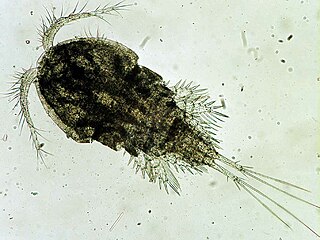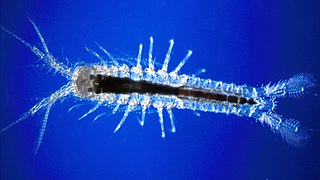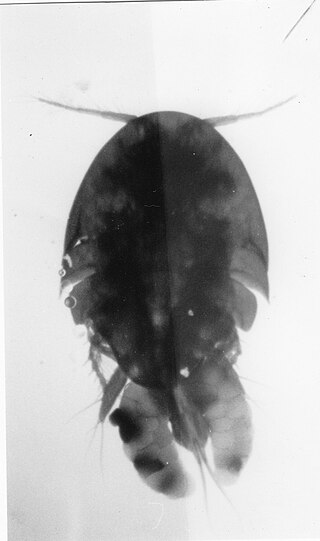
The Cyclopoida are an order of small crustaceans from the subclass Copepoda. Like many other copepods, members of Cyclopoida are small, planktonic animals living both in the sea and in freshwater habitats. They are capable of rapid movement. Their larval development is metamorphic, and the embryos are carried in paired or single sacs attached to first abdominal somite.

Poecilostomatoida are an suborder of copepods. Although it was previously considered a separate order, recent research showed it to be nested within the Cyclopoida
Polycopidae is a family of marine ostracods. Its members are related to animals in the suborder Halocypridina, but are sufficiently distinct to be placed in the sub-order Cladocopina. There is even some speculation that a separate order may be warranted. The genera in the family differ from the other suborder, Halocypridina, in several features: the central adductor muscle scars are in a triangular or half-rosette pattern, they lack sixth and seventh limbs, and the maxilla has both an exopod and endopod.

Mictocaris halope is the only species of cave crustacean in the monotypic genus Mictocaris. It is placed in its own family, Mictocarididae, and is sometimes considered the only member of the order Mictacea. Mictocaris is endemic to anchialine caves in Bermuda, and grows up to 3.5 mm (0.14 in) long. Its biology is poorly known.
Parhippolyte sterreri is a species of marine decapod crustacean in the family Barbouriidae, formerly placed in the genus Somersiella. It is found in marine caves around the Bahamas, Cuba and Mexico and inland anchialine caves in Bermuda.
Speleoithona is a genus of copepods in the family Speleoithonidae, containing the following species:
Speleophria bivexilla is a species of copepod in the family Speleophriidae. It is endemic to Bermuda.
Speleophria is a genus of marine copepods in the family Speleophriidae. It contains the following species:
Speleophria scottodicarloi is a species of crustacean in the family Speleophriidae. It is endemic to Chalk Cave, a collapsed cave in Smith's Parish, Bermuda, and it listed as critically endangered on the IUCN Red List. The pool it inhabits also contains Barbouria cubensis, Somersiella sterreri and Paracyclopia naessi.

Typhlatya is a genus of shrimp in the family Atyidae. These are small, stygobitic shrimp found in the West Mediterranean region, Caribbean region, Ascension Island and the Galápagos, although the individual species often have very small ranges. Species in this genus are found in salt, brackish and fresh waters, mostly in anchialine habitats and none in the open sea.

The Cyclopidae are a family of copepods containing more than half of the 1,200 species in the order Cyclopoida in over 70 genera.

Clausidiidae is a family of parasitic copepods of the suborder Poecilostomatoida, containing the following genera:

Platycopiidae is a family of copepods. Until the description of Nanocopia in 1988, it contained the single genus Platycopia. It now contains four genera, three of which are monotypic; the exception is Platycopia, with 8 species.
Geoffrey Allan Boxshall FRS is a British zoologist, and Merit researcher at the Natural History Museum, working primarily on copepods.

Misophrioida is an order of copepods, containing the following families:
Hirsutiidae is a family of crustaceans, classified either as a separate order, Bochusacea, or as part of a wider Mictacea. It comprises five species in three genera:
Pseudocyclopiidae is a family of copepods, comprising the following genera:

Xibalbanus tulumensis is a venomous, hermaphroditic crustacean found in anchialine caves on the Yucatán Peninsula in the Caribbean Sea. This blind remipede liquefies the body contents of other crustaceans with a venom similar to that of rattlesnakes, and which includes digestive enzymes and a paralysing toxin.
Epacteriscidae is a family of copepods belonging to the order Calanoida.

Misophriidae is a family of copepods belonging to the order Misophrioida.








